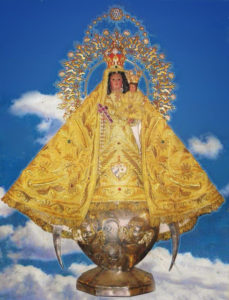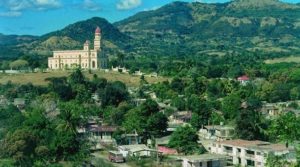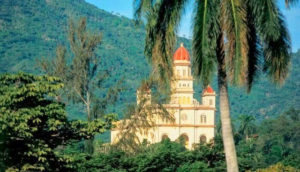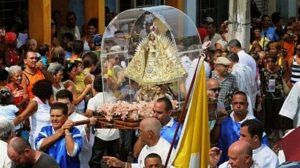APPEARANCE OF “CACHITA”, THE VIRGIN OF THE CHARITY OF EL COBRE. THE HISTORICAL LEGEND.
In the Basilica National Sanctuary of Our Lady of Charity of the Copper the original image of the one found in the year of 1612 in the waters of the Bay of Nipe in the province of Oriente is conserved, this one is of gold and can be seen from all the corners Of the main ship.
The story narrated under the Church’s oath at age 85 by Juan Moreno, who tells the story as “the Negrito de La Caridad” tells how he and two Indian brothers, Juan and Rodrigo de Hoyos, in search of salt, were in a boat Leaving Cayo Francés in the Bay of Nipe, the largest in the country and located on the north coast of the eastern region of the island. On the way to their destination, they observed something floating on the sea. As they approached, they saw with amazement that it was an image of the well-known ‘Virgin Mary’ on a tablet where you could read: “I am the Virgin of Charity.”
The legend says that the image was found the three slaves: this black boy of 10 years (Juan Moreno) and two brothers of Indian blood (Juan and Rodrigo de Hoyos), of the few that survived the conquest and that worked like slaves in The copper mines of the region. The trio has been baptized in Cuban imagery as “the three Juanes”.
The Indians and the Negro carried the image to the town of Real de Minas, very close to the town of Santiago de Cuba, where one of the largest open-hearted copper veins of America was opened. The neighbors received the find as a good sign of the sky and immediately built a hermitage to serve as a temple to the religious idol.
The initial sanctuary was built improvised, using guano leaves and boards. After many mysterious events occurred around the image, it was taken to what would be its definitive sanctuary, a short distance away, on the top of a hill near the copper mines.
Its first place as sanctuary in 1906 collapsed product of the explosions and excavations of the mines. The current Copper Sanctuary, which offers mass every morning, was inaugurated on September 8, 1927 and has a massive silver altar and other ornamental objects of great value.
Underneath the Chapel of the Virgin is the Chapel of the Miracles, a small enclosure where the believers deposit dissimilar offerings: gold and precious jewels, crutches, toys, jewelry, letters, photos, diverse prizes and even medals of the most Varied origin. Land of other countries, military degrees, chains, watches, rings, Olympic medals, university diplomas to a kidney stone displayed in a small box, letters and photographs resting on tables. Military epaulettes, military medals, silver objects, miniature arms and legs, symbols of miracles produced, among other riches of values, are lined up in the windows and on the walls. About 500 people flock to the site each day. Next to the Sanctuary is the San Basilio El Magno Seminary and a modest inn served by members of a religious order. There you can spend the night if you want or take some food.
The devotion for the Virgin in relation to the National Identity resists any attempt at classification. Their devotion is an element consubstantial to our identity as a people. A component of nationality, such as the palm, the shield, the flag, which are the symbols of the motherland. It entails a symbol of faith, capable of distinguishing us as a nation.
APARICIÓN DE “CACHITA”, LA VIRGEN DE LA CARIDAD DEL COBRE. LA LEYENDA HISTÓRICA.
En la Basílica Santuario Nacional de Nuestra Senora de la Caridad del Cobre se conserva la imagen original de la encontrada en el año de 1612 en las aguas de la Bahía de Nipe, provincia de Oriente, esta es de oro y puede verse desde todos los rincones de la nave principal.
La historia narrada bajo juramento eclesiástico a los 85 años por Juan Moreno, que la historia cuenta como “el Negrito de La Caridad” relata cómo él y dos hermanos indios, Juan y Rodrigo de Hoyos, en busca de sal, se encontraban en un bote saliendo de Cayo Francés en la Bahía de Nipe, la mayor del país y situada en la costa norte de la región oriental de la isla. Camino hacia su destino observaron ellos algo flotando en el mar, al acercarse vieron con asombro que se trataba de una imagen de la conocida ‘Virgen María’ sobre una tablilla donde se podía leer: “Yo Soy La Virgen de La Caridad”.
La leyenda asegura que la imagen fue encontrada los tres esclavos: este muchacho negro de 10 años (Juan Moreno) y dos hermanos de sangre india (Juan y Rodrigo de Hoyos), de los pocos que sobrevivieron a la conquista y que trabajaban como esclavos en las minas de cobre de la región. El trío ha quedado bautizado en la imaginería cubana como “los tres Juanes”.
Los indios y el negrito llevaron la imagen hasta el poblado Real de Minas, muy cerca de la villa de Santiago de Cuba, donde se abría una las mayores vetas de cobre a cielo abierto de América. Los vecinos recibieron el hallazgo como una buena señal del cielo y construyeron de inmediato una ermita para que sirviera de templo al ídolo religioso.
El santuario inicial se construyó de manera improvisada, empleando hojas de guano y tablas. Tras múltiples sucesos misteriosos ocurridos en torno a la imagen, ésta fue llevada al que sería su santuario definitivo, a poca distancia de allí, en la cima de una loma cercana a las minas de cobre.
Su primer lugar como santuario en 1906 se desplomó producto de las explosiones y excavaciones de las minas. El actual Santuario del Cobre, que ofrece misa cada mañana, se inauguró el 8 de septiembre de 1927 y tiene un altar de plata maciza y otros objetos ornamentales de gran valor.
Debajo del Camarín de la Virgen se encuentra la denominada Capilla de los Milagros, un pequeño recinto donde los creyentes depositan disímiles ofrendas: joyas de oro y piedras preciosas, muletas, juguetes, joyas, cartas, fotos, premios diversos e incluso medallas de la más variada procedencia. tierra de otros países, grados militares, cadenas, relojes, anillos,medallas olímpicas, diplomas universitarios a un cálculo renal expuesto en una pequeña caja, cartas y fotografías reposan sobre mesas. En las vitrinas y en las paredes se alinean charreteras militares, medallas castrenses, objetos de plata, brazos y piernas en miniatura, símbolos de milagros producidos, entre otras riquezas de valores. Unas 500 personas acuden al lugar cada día. Junto al Santuario se encuentra el Seminario San Basilio El Magno y una modesta hospedería atendida por miembros de una orden religiosa. Allí podrá pernoctar si lo desea o tomar algún alimento.
La devoción por la Virgen en relación con la Identidad Nacional se resiste a cualquier intento clasificatorio. Su devoción es un elemento consustancial a nuestra identidad como pueblo. Un componente de la nacionalidad, como la palma, el escudo, la bandera, que son los símbolos de la patria. Ella entraña un símbolo de la fe, capaz de hacernos distinguir como nación.
Agencies/MemoriasCubanas/Carlos Rodríguez/Extractos/ Internet Photos/ Arnoldo Varona/ TheCubanHistory.com
THE CUBAN HISTORY, HOLLYWOOD.








